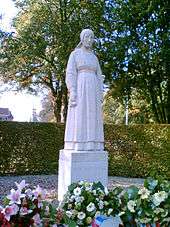Putten raid
The Putten raid (Dutch: Razzia van Putten) was one the worst civilian raids conducted by Nazi Germany in occupied Netherlands during the Second World War. On 1 October 1944, a total of 602 men - almost the entire male population of the village - were taken from Putten, in the central Netherlands, and deported to various concentration camps inside Germany. Only 48 returned at the end of the war. The action was undertaken as a reprisal for a Dutch resistance attack on a vehicle carrying personnel from the Wehrmacht.
Background
On the night of 30 September-1 October 1944, a car carrying two officers and two corporals of the German Army was ambushed by members of the Dutch resistance near the Oldenallerbrug bridge between Putten and Nijkerk. In the attack, a resistance fighter named Frans Slotboom was wounded but later died. One German officer, Leutnant Otto Sommer, was also injured, escaped to a nearby farmhouse to raise the alarm; but died the following day. The two German corporals fled while the second officer, Oberleutnant Eggart, was injured and captured. Due to his wounds, the resistance fighters abandoned him in a place where he could be found by the Germans.
German reprisal

The German reprisal raid was conducted the following day. At the command of General Friedrich Christiansen, Putten was surrounded by German forces led by Fritz Fullriede. The women and men of the village were captured and separated, and over one hundred houses in the village were set on fire. Six men and a woman were shot dead during the raid. The women were held at the church until 9pm, while the men and boys were detained separately nearby at the village school. On 2 October, 661 men between the ages of 18 and 50 were taken to Amersfoort concentration camp, where 59 older or unfit men were released. The remaining 602 men left Amersfoort on 11 October and taken to Neuengamme concentration camp as forced labour. During the transportation, 13 men escaped by jumping from the train. From Neuengamme, some were moved on to other camps or sub-camps, including Ladelund, Bergen-Belsen, Meppen-Versen, Beendorf, Wöbbelin and Malchow. Only 48 men returned after the end of the war, but another 5 died from their mistreatment after they arrived home. Some people returned crippled as they were kept in small cages they could not stand in. A total of 552 men and 1 woman died, mostly victims of malnutrition, slave labour and infectious diseases.
Memorials


A monument commemorating the victims of the raid was unveiled by Queen Juliana on 1 October 1949. The monument includes a memorial park designed by Jan Bijhouwer and a sandstone statue by Mari Andriessen depicting a grieving woman in traditional dress with a handkerchief in her hand, known as "The Lady of Putten". The statue looks toward the Oude Kerk in Putten, from where the men were deported.
A silent memorial held at the monument on 2 October each year, attended by hundreds of people. Wreaths are laid by the College van Burgemeester & Wethouders (Dutch: The College of the Mayor and Municipal Executive), the "Stichting Oktober '44" (Dutch: The October '44 Foundation), a few surviving returnees, schoolchildren from Putten, and other organizations from the Netherlands and abroad.
Coordinates: 52°15′N 5°32′E / 52.25°N 5.53°E
See also
References
Based on the Dutch-language version at nl:Razzia_van_Putten
- Resistance in Western Europe, Bob Moore, Berg, 2000, ISBN 1-85973-279-8, p. 206
- "Sa Wie It", George Sjouke Riemersma, Xlibris Corporation, 2010, ISBN 1-4535-8706-3, p. 65
- Surviving Hitler and Mussolini: daily life in occupied Europe, Robert Gildea, Berg, 2006, ISBN 1-84520-181-7, p. 196
- ww2museums.com
- putten.nl
- Stichting Oktober '44
- Website Stichting Oktober 44, stichting ter gedenking van de razzia
- Lijst van weggevoerde mannen
- Het verhaal van Jannes Priem